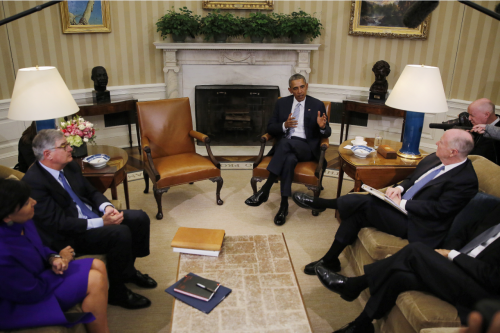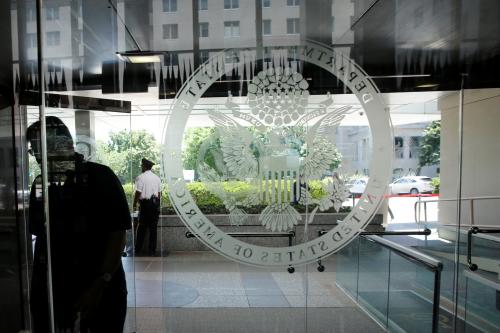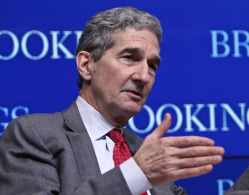With a bundle of Senate confirmations of Trump appointees just before the August congressional recess, it’s a good time to take stock of what progress the Trump administration has made in filling the positions that shape policy in the digital arena.
My Brookings paper last fall, Bridging The Internet-Cyber Gap: Digital Policy Lessons for the Next Administration, included a “digital plum book” that identified the positions from the full Plum Book (the Government Printing Office compilation of senior federal positions that is a roadmap to presidential appointments) with real impact on the constellation of issues that affect the digital economy and digital society. To see how the Trump administration is doing, we used the digital plum book as a scorecard.
There are 95 positions in the digital plum book. For 65 of these positions, the administration has at least announced a nominee, and 37 of these have been confirmed to date. This compares favorably to unfilled positions overall: the Partnership for Public Service counts 117 confirmed out of 591 positions, with another 106 pending nominations as of this writing. The digital plum book also identified 32 positions as jobs where a broad understanding of digital issues is critical to the mission. Of these, 13 have been filled and another two have been announced. For the remainder, 12 are being filled in an acting capacity, and the other five are vacant altogether.
This reflects attention to appointments on the “hard” side of digital issues, (cybersecurity and cyber conflict). When it comes to positions that deal with the economic, political, and diplomatic aspects of digital technology, though, the administration is lagging behind, and appears to shedding rather than filling key positions.
Executive Office appointments
At the White House, Deputy National Security Adviser for Homeland Security and Counterterrorism Tom Bossert and National Security Council Cyber Coordinator Rob Joyce hold key positions overseeing cybersecurity and other “hard” issues. Both are experienced cybersecurity professionals who spearheaded a balanced executive order on cybersecurity that was notable for its continuity with existing policies, including a declaration of “the policy of the executive branch to promote an open, interoperable, reliable, and secure internet that fosters efficiency, innovation, communication, and economic prosperity.”
Among the positions that deal with this declared policy, though, the Executive Office of the President is a virtual wasteland. The Office of Science and Technology Policy is notoriously almost empty except for a deputy chief technology officer. It does not appear that anyone on the National Economic Council is particularly focused on the digital economy. The administration briefly included Deputy National Security Adviser for International Economic Affairs Kenneth Juster, but he left in June in a lower profile departure of senior staff. Both Juster and his reported replacement have trade backgrounds.
The one White House office that seems to touch on such policy is the new Office of American Innovation (OAI), adding to Jared Kushner’s array of portfolios. OAI has taken an interest in the U.S. Digital Service as vehicle for technology as a tool innovate in government, and the recently-departed head of the U.S. Digital Service was asked to hold over.
Cabinet department appointments
Across the executive branch, the picture is similar, with less in place on the cybersecurity side and at least something to show for the digital economy. The operating agencies for cybersecurity are seriously short of political leadership with the resignation of Homeland Security Secretary John Kelly to move to the White House and appointment of an undersecretary for the National Protection and Programs Directorate held up by discussion of a reorganization, now likely to go on hold pending the confirmation of a new secretary. No undersecretary of defense for policy has been named.
The Commerce Department has had several nominees confirmed or in the pipeline. One, General Counsel Peter Davidson, with a background similar to mine in that he has worked as a telecommunications lawyer, and David Redl, a Senate Commerce Committee staffer, both bring grounding in technology issues. At the State Department, though, the evident freeze on subcabinet appointments leaves the mission-critical digital plum book positions unfilled.
Notably, two positions that were identified in my Internet-Cyber Gap paper as important indicators of high-level commitment to digital economy issues seem to be disappearing. At Commerce, the position under the secretary of senior adviser for the digital economy has not been filled and it appears it will not be. At State, as I have discussed in this space previously, Cyber Coordinator Christopher Painter has left and it is reported his office will be disbanded.
The Trump administration has put heavy emphasis on revisiting trade agreements and invoking trade remedies in aging industrial sectors like steel. Despite America’s preeminence in technology and emerging digital sectors, it is not apparent that the latter play any significant role in its vision for economic nationalism. Its record of appointments relevant to these sectors certainly suggests that they do not. A strategy for international engagement on cybersecurity is due September 23 according to the May 11 executive order on cybersecurity, but the administration is seriously short on the appointees it needs to consider that strategy in all its dimensions.
Jeffrey Wirjo contributed research to this post.
The Brookings Institution is committed to quality, independence, and impact.
We are supported by a diverse array of funders. In line with our values and policies, each Brookings publication represents the sole views of its author(s).








Commentary
Trump administration overlooks critical digital policy posts
August 25, 2017